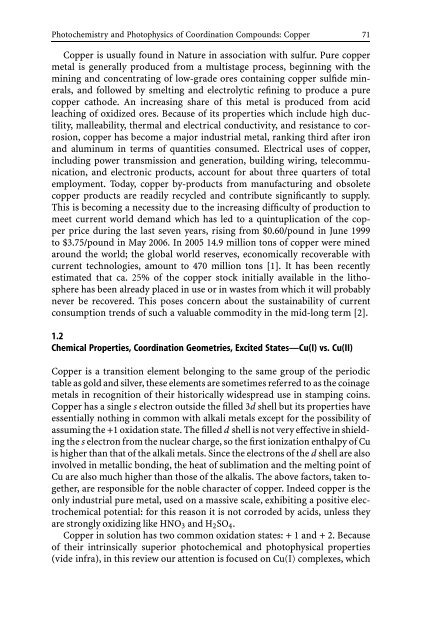Photochemistry and Photophysics of Coordination Compounds
Photochemistry and Photophysics of Coordination Compounds
Photochemistry and Photophysics of Coordination Compounds
Create successful ePaper yourself
Turn your PDF publications into a flip-book with our unique Google optimized e-Paper software.
<strong>Photochemistry</strong> <strong>and</strong> <strong>Photophysics</strong> <strong>of</strong> <strong>Coordination</strong> <strong>Compounds</strong>: Copper 71<br />
Copper is usually found in Nature in association with sulfur. Pure copper<br />
metal is generally produced from a multistage process, beginning with the<br />
mining <strong>and</strong> concentrating <strong>of</strong> low-grade ores containing copper sulfide minerals,<br />
<strong>and</strong> followed by smelting <strong>and</strong> electrolytic refining to produce a pure<br />
copper cathode. An increasing share <strong>of</strong> this metal is produced from acid<br />
leaching <strong>of</strong> oxidized ores. Because <strong>of</strong> its properties which include high ductility,<br />
malleability, thermal <strong>and</strong> electrical conductivity, <strong>and</strong> resistance to corrosion,<br />
copper has become a major industrial metal, ranking third after iron<br />
<strong>and</strong> aluminum in terms <strong>of</strong> quantities consumed. Electrical uses <strong>of</strong> copper,<br />
including power transmission <strong>and</strong> generation, building wiring, telecommunication,<br />
<strong>and</strong> electronic products, account for about three quarters <strong>of</strong> total<br />
employment.Today,copperby-productsfrommanufacturing<strong>and</strong>obsolete<br />
copper products are readily recycled <strong>and</strong> contribute significantly to supply.<br />
This is becoming a necessity due to the increasing difficulty <strong>of</strong> production to<br />
meet current world dem<strong>and</strong> which has led to a quintuplication <strong>of</strong> the copper<br />
price during the last seven years, rising from $0.60/pound in June 1999<br />
to $3.75/pound in May 2006. In 2005 14.9 million tons <strong>of</strong> copper were mined<br />
around the world; the global world reserves, economically recoverable with<br />
current technologies, amount to 470 million tons [1]. It has been recently<br />
estimated that ca. 25% <strong>of</strong> the copper stock initially available in the lithosphere<br />
has been already placed in use or in wastes from which it will probably<br />
never be recovered. This poses concern about the sustainability <strong>of</strong> current<br />
consumption trends <strong>of</strong> such a valuable commodity in the mid-long term [2].<br />
1.2<br />
Chemical Properties, <strong>Coordination</strong> Geometries, Excited States—Cu(I) vs. Cu(II)<br />
Copper is a transition element belonging to the same group <strong>of</strong> the periodic<br />
table as gold <strong>and</strong> silver, these elements are sometimes referred to as the coinage<br />
metals in recognition <strong>of</strong> their historically widespread use in stamping coins.<br />
Copper has a single s electron outside the filled 3d shell but its properties have<br />
essentially nothing in common with alkali metals except for the possibility <strong>of</strong><br />
assuming the +1 oxidation state. The filled d shell is not very effective in shielding<br />
the s electron from the nuclear charge, so the first ionization enthalpy <strong>of</strong> Cu<br />
is higher than that <strong>of</strong> the alkali metals. Since the electrons <strong>of</strong> the d shell are also<br />
involved in metallic bonding, the heat <strong>of</strong> sublimation <strong>and</strong> the melting point <strong>of</strong><br />
Cu are also much higher than those <strong>of</strong> the alkalis. The above factors, taken together,<br />
are responsible for the noble character <strong>of</strong> copper. Indeed copper is the<br />
only industrial pure metal, used on a massive scale, exhibiting a positive electrochemical<br />
potential: for this reason it is not corroded by acids, unless they<br />
are strongly oxidizing like HNO3 <strong>and</strong> H2SO4.<br />
Copper in solution has two common oxidation states: + 1 <strong>and</strong> + 2. Because<br />
<strong>of</strong> their intrinsically superior photochemical <strong>and</strong> photophysical properties<br />
(vide infra), in this review our attention is focused on Cu(I) complexes, which

















